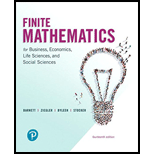
Concept explainers
Product switching. A company's brand
(A) Draw a transition diagram.
(B) Write a transition matrix.
(C) Write the initial-state matrix.
(D) Find the first-stale matrix and explain what it represents.
(E) Find the stationary matrix.
(F) What percentage of the market will brand
Want to see the full answer?
Check out a sample textbook solution
Chapter 9 Solutions
Finite Mathematics for Business, Economics, Life Sciences and Social Sciences
Additional Math Textbook Solutions
Calculus for Business, Economics, Life Sciences, and Social Sciences (14th Edition)
Calculus: Early Transcendentals (2nd Edition)
Elementary Statistics: Picturing the World (7th Edition)
Elementary Statistics (13th Edition)
- Only 100% sure experts solve it correct complete solutions need to get full marks it's my quiz okkkk.take your time but solve full accurate okkk Geometry expert solve itarrow_forward3. Let sin (22) + cos (T2) f(z) = z(22 + 1)(z+1) Compute f(z)dz over each of the contours/closed curves C1, C2, C3 and C4 shown below. L 10 -C x Don't use any Al tool show ur answer pe n and paper then takearrow_forwardwhat is the slope of the linear equation-5x+2y-10=0arrow_forward
- 1. Evaluate (2,5) (3x+y)dx+(2y-x)dy (0,1) (i) along the straight lines from (0, 1) to (2, 1) and then from (2, 1) to (2,5), and (ii) along the parabola y = x² + 1. Don't use any Al tool show ur answer in pe n and paper then takearrow_forwardDon't use any Al tool show ur answer in pe n and paper then take 20. Solve the given system of differential equations: x' = x+y, x(0) = 0 y' = 2x, y(0) = 1arrow_forward4. Verify the Cauchy-Goursat theorem for the function f(z) =225z around the closed curve C defined by a half circle || = 1 from the point (1,0) to (-1, 0) in the counterclockwise direction and then the straight line from (-1,0) to (1,0). Don't use any Al tool show ur answer in pe n and paper then takearrow_forward
- 2. Evaluate the following integral using cauchy integral theorem: ||=3 sin (22)+cos (22) (2-1)(2-2) -dz Don't use any Al tool show ur answer in pe n and paper then takearrow_forward18. Solve the given differential equation: y' + y = f(t), y(0) = 5, where f(t) = 0arrow_forward16. Solve the given differential equation: y" + 4y Given, = sin (t)u(t2), y(0) = 1, y'(0) = 0 1 = (x² + 1)(x²+4) 1/3 -1/3 + x²+1 x²+4 Don't use any Al tool show ur answer in pe n and paper then takearrow_forwardarrow_back_iosSEE MORE QUESTIONSarrow_forward_ios
 Elementary Linear Algebra (MindTap Course List)AlgebraISBN:9781305658004Author:Ron LarsonPublisher:Cengage Learning
Elementary Linear Algebra (MindTap Course List)AlgebraISBN:9781305658004Author:Ron LarsonPublisher:Cengage Learning Functions and Change: A Modeling Approach to Coll...AlgebraISBN:9781337111348Author:Bruce Crauder, Benny Evans, Alan NoellPublisher:Cengage Learning
Functions and Change: A Modeling Approach to Coll...AlgebraISBN:9781337111348Author:Bruce Crauder, Benny Evans, Alan NoellPublisher:Cengage Learning

